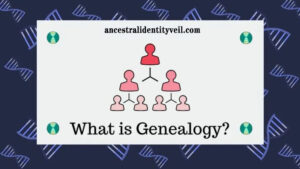Have you heard about genealogy but are unclear on its definition and purpose? In this article, discover more by learning the definition, examples and how genealogy operates.

There can be some misconceptions when it comes to genealogy research, which I hope this article helps dispel. If you’re just getting started or learning how much fun family history research can be, I hope this piece provides clarity and helps guide your efforts in the right direction.
Genealogy refers to the study of history for a particular person or family by researching all ancestors who share an ancestral link, often starting with direct relatives such as parents, grandparents and great-grandparents.
As researchers gain more expertise, they will likely begin searching for collateral relatives as part of their search strategy. Collateral relatives include siblings of our ancestors such as brothers and sisters of grandparents or their descendants as well as any collateral relatives they might find themselves connected with.
Studies on extended family members can give us invaluable insights into our family tree and identify important ancestor clues.
Genealogy research is typically undertaken by amateur hobbyists. However, there are also paid professionals trained both self-taught and formally educated in genealogy research methods who offer professional genealogy services as a paid service for clients.
I am an advocate of anyone wanting to learn how to conduct their own genealogy and family history research. It can be an enjoyable hobby with no cost attached; many free websites exist that contain family tree records as well as Ancestry which offer tree building tools.
Are we discussing genealogy as a science?
People tend to view occupations with words ending in “ology” as scientific fields; so is genealogy one? Yes. Genealogy is the study of researching family histories.
Genealogists who are experts at their craft – both professionally trained and self-taught and experienced alike – adhere to stringent rules when collecting, evaluating and citing evidence for genealogy research projects.
Genealogist skills and expertise are becoming more respected across various fields. Thanks to DNA testing, genealogists are being called on as experts when investigating crimes.
Genealogy and Ancestry Its They may seem interchangeable; however, there are subtle distinctions. Ancestry generally refers to where our family hails from or our ethnic heritage while genealogy primarily deals with our personal genealogy.
One definition of an individual’s ancestry could be defined as the general region from where their ancestors originated; they might for instance claim they have Nigerian and British roots, for instance.
Genealogy refers to the study of one’s exact ancestors going back as far as possible; so for example if someone’s ancestry is English but their genealogy includes William the Conqueror or Charlemagne as possible sources, for example.
Are Family Trees Related to Genealogy? No. Genealogists create family trees as part of their work by gathering and organizing records they discover to create one large family tree.
Notice how I didn’t call family trees the “end product” of genealogy research – this is because those of us who enjoy studying our ancestry find that our work never really concludes completely.
However, most people have goals in mind when conducting genealogy research. For example, many Americans have immigrant ancestors from various parts of the globe, and one stated goal for many American family tree researchers is discovering where all their immigrant ancestors were born.
Once complete, researchers might organize their findings into a family tree and distribute it along with any records or photos acquired during their work to members of their own family.
What Is an Example of Genealogy? mes When researching genealogy, one expects to encounter charts. Genealogical research can often be organized in this way – such as family trees and pedigree charts.
The chart below is an example of a genealogy or family tree chart which displays only biological descendants of Samuel Smith. Micheal, shown at the bottom left corner of this sample chart is considered “home.”
This genealogy chart for Micheal, the home person, shows everyone who descends from Samuel Smith, his great-great grandfather.
At its core, every individual on this chart is directly descended from Samuel – Micheal’s great-great grandfather – yet each has a specific relationship to Micheal depending on how far back in their family tree they can trace their descent from Samuel; these relationships are detailed within the chart itself.
Micheal has several third cousins. These individuals include anyone descended from Samuel one generation closer, which are considered his second cousins once-removed.
Excepting them are Nick, Micheal’s brother; Susan and George who are his mother and uncle respectively. These individuals differ in that they share more recent common ancestors with Micheal than Samuel did.
The chart also depicts Micheal’s first cousins twice-removed, Samuel’s grandchildren who aren’t direct ancestors of Micheal and Joseph – Micheal’s great-granduncle who was Samuel’s child and was Mark’s sibling.
Conclusion
My hope is that this post has provided all the answers to your questions about genealogy, its difference from ancestry and provided valuable examples to demonstrate its usefulness.
If you have any inquiries about anything written here or an aspect of genealogy that needs further explanation, or would simply like someone to talk with on these matters, feel free to join the discussion in the box below.
Leave a Reply